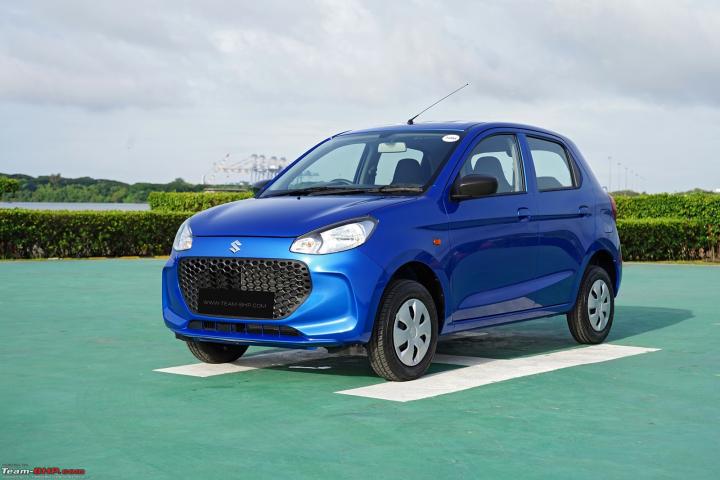News
Why are Entry-level cars falling out of favour?
There is a big section of Indian society who are restricted to two wheelers only because of budget constraints and many of them migrate to entry level cars as and when possible.
BHPian cludflare recently shared this with other enthusiasts.
Buying a first car can be a very difficult discussion for many. With India shining, most of us would end up owning at least 4 to 5 cars in our lifetime if not more. But the first one is always special. There are different opinions that people hold around first cars – some believe a used car is the best way to get your hands accustomed and then move to a new one, some believe that in the new age one can directly own an automatic and skip the manual world completely, some do not want to compromise on safety these days at all, while for many it’s a pure decision of affordability.
There is a big section of Indian society who are restricted to two wheelers only because of budget constraints and many of them migrate to entry level cars as and when possible. This is one space that I have a particular interest in. I live in Bangalore and often notice that there is an increasing drop in the number of Altos and Celerios on the road, which is understandable with Bangalore having the highest per capita income in the country. But unlike the big cities, this segment is extremely important for a massive part of India. For many of us, the first car was always an entry level car which might be changing now.
Maruti Suzuki’s chairman recently shared his view in their half yearly press conference about the significant drop-in entry-level car-space.
The objective of this post is to have some discussion around the lack of options and OEMs disappearing from this space and second, the importance of safety features in the segment.
Even if MSIL’s sales numbers from this segment remain high, this is not a value segment. I have deep respect for Maruti Suzuki to continue to focus on the demography that buys their first car based on affordability. Decade over decade, Maruti has ensured that the Indian customer is not running out of options at all non-premium price points. While others like Hyundai chose to fold, Maruti holds the fort. It was extremely sad to see first the Eon followed by the Santro coming under the axe. The cheapest Hyundai (Nios - Era) now costs 7 lakhs on road. On the other hand, Maruti still offers the lower middle class buyer the option to chose from Alto, Celerio, Wagon R and even the Ignis priced aggressively. Also notable mentions are the Kwid and Tiago still being around.
I understand that with the commodity costs on the up and the tax treatment for foreign players (excluding Koreans) makes the business less viable in this segment. That makes me think about the mandate of having 6 airbags for all cars. I do believe safety is very important aspect of a car, and it should be one of the top priorities for all car buyers, if you can afford it. But there are millions of Indians who will want to upgrade to an entry level hatch from their scooters – don’t bump in their costs.
Kudos to Tata Motors for raising our awareness towards safety, but hey – don’t mock S-Presso in your social handle for 0 stars. You are not the one offering a car at 4 lakh ex-showroom.
Here's what BHPian The_Rationalist had to say on the matter:
You are simply nitpicking on TATA. The cheapest car, Alto costs ₹4.6 lakh in Kerala, Tiago costs ₹6.6 lakh. In EMI terms it’s around ₹4000. There will be very minuscule percentage of people who can afford a Alto but not a Tiago! The sales of the cheapest 3 cars in India is <5% of total sales! So the percentage who can’t afford a Tiago, yet able to afford an Alto will be less than 5% of car buyers.
Let us assume a person wants to buy a car. I bought my first car 20 years back, it was an used Zen, I drove it for 14 years. Mind you there were less options then. Now for the cost of an Alto you can get lot of good used cars. So, it is not that cost of entry level cars is high, the country has grown up in income and that is reflected in car sales. My first car was bought for ₹3 lakh in 2002, so with regard to inflation the car prices has not grown that much. ₹3 lakh in inflation terms would be ₹11 lakh now. That means while the former could only afford me a Zen, that too a used one, now for same inflation adjusted money I can almost get a new Virtus/Slavia! We can simply crib on imaginary issues, while the fact is entirely different.
Here's what BHPian Aakash118 had to say on the matter:
More than anything, it’s the decreasing aspirational value of cars like Alto & Celerio which is responsible for downfall of this segment. I know at least 3-4 people in my circle who bought their first car in the form of a used i10 or Ritz, learned driving on it and then directly upgraded to a Nexon or Creta. A new Alto or even Tiago is just not aspiring enough for them.
Here's what BHPian ninjatalli had to say on the matter:
Buying a car is a big jump for a lot of middle-class Indians; but for the same, the decision also focuses on maintenance costs. And with regards to that aspect, Maruti leaps ahead by a huge margin. In reality, the cost of ownership for a Maruti might not be very far from a Hyundai in the same segment, when serviced at regular service centers. But from a mindset, Maruti still screams as value-for-money for the average fellow on the road. And that also gets revalidated when one goes to an FNG or tries to sell an existing Maruti car.
I believe the likes of Hyundai, Tata and others have realized they can't fight this and have "shifted" their entry level segment range while focusing on other aspects (e.g. safety, gadgetry). Maruti would love to do so but the bottom of the pyramid is still a cash-cow for them (even if the margins are very low) and hence they have to make-do with whatever possible (e.g. limited safety features). I expect over time the old models (Alto, etc.) will be phased out eventually.
Here's what BHPian M_powerred had to say on the matter:
I believe its the easy availability of EMIs and loans. People with jobs can easily sign a few documents and add one more year to their loan tenure and get a car thats segment above. Hence everyone is going for it. Since the idea of having more than one EMIs is getting accepted by the younger earning population, from EMIs for the new iphone and a car feels mostly similar. So why not? Is the question of the new earners. I am not saying anyone is being financially irresponsible with their funds, because at the end YOLO...
Here's what BHPian rishi.roger had to say on the matter:
There is not a substantial difference between 5 lakh and 10 lakhs these days. If someone can purchase a 5 lakh car, buying a used or even a new 8-9 lakh car won't be very difficult. Thanks to the financing scheme provided by banks, and also a change in purchase mentality in modern Indian population (particularly those in Metro/Tier-1 and some Tier-2 cities).
Social media content also has a lot of influence on the youth.I think the puzzle could be solved further if one gets their hands on amount of cars that have been sold on loan, % of loan amount and age groups they're sold to.
I feel, A lot of people buying cars these days are youngsters, who don't mind the burden of EMIs as they see a bright future for Indian economy. They understand that for sure, they could get an Alto right now but soon enough they'll earn more and desire more - so why not put their money somewhere that's also slightly future proof in terms of meeting the desire/needs.
Read BHPian comments for more insights and information.



















